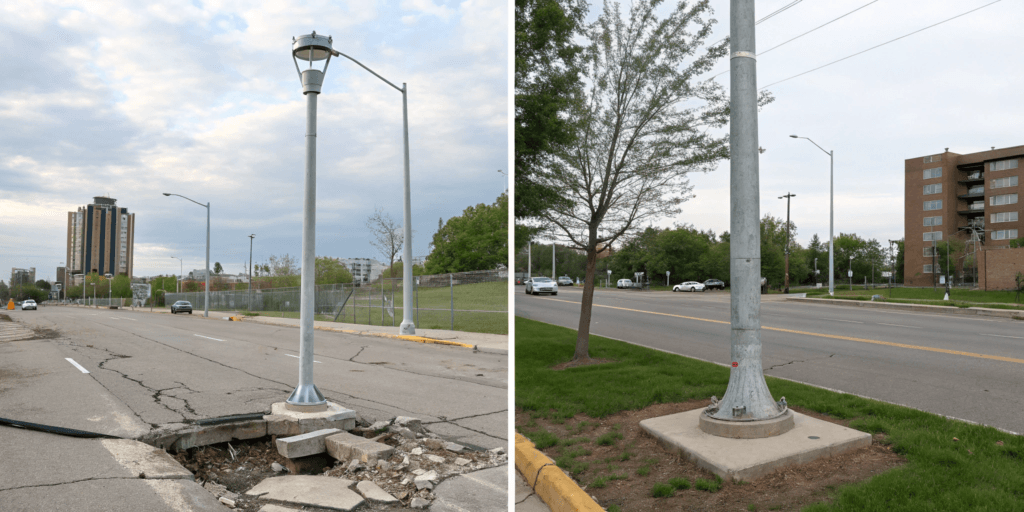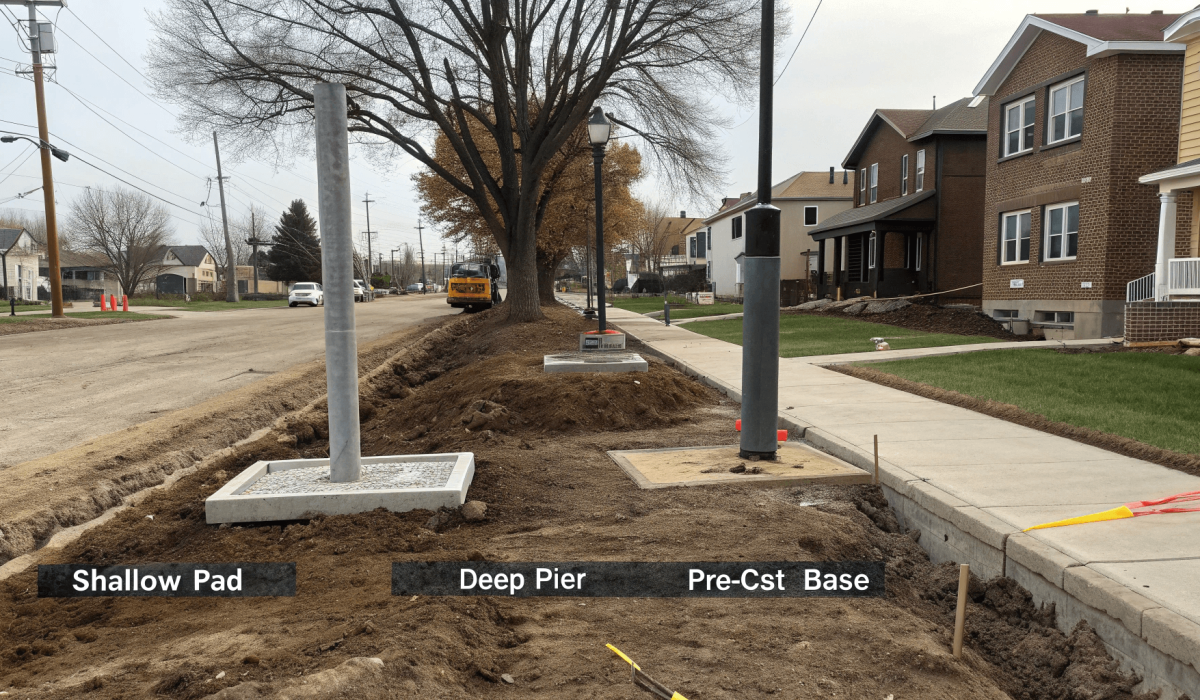The wrong foundation can make even the strongest street light pole unsafe.
Choosing the right foundation ensures safety, long-term performance, and cost-efficiency.
In this guide, I’ll break down each foundation type, explain when to use it, and help you avoid common mistakes in foundation planning.
What Influences Foundation Type Selection?
Every project is different, and so is its ideal foundation.
Pole height, soil type, location, and cost all influence which foundation will work best.
Here are the main factors I consider:
-
Pole Height and Design
Taller poles need stronger and deeper foundations. Poles with extra weight (like solar panels or banners) also need better anchoring. -
Wind Load and Environmental Conditions
Coastal zones or open highways face stronger winds. Some areas also need seismic considerations. -
Soil Type and Load-Bearing Capacity
Soft, sandy, or clay soil types require advanced foundation solutions. -
Installation Location
Urban streets, rural roads, and parks all have different traffic and maintenance needs. -
Timeline and Budget
Fast-track projects may benefit from precast or helical foundations, while long-term builds can accommodate concrete curing time.
Main Types of Street Light Pole Foundations?
Not all foundations are created equal.
There are five main types, each designed for specific ground conditions, pole sizes, and project goals.
s](https://sunlurio.com/wp-content/uploads/2025/03/imagine-prompt-a-comparative-infographic-showing-1024x512.png)
1. Direct Burial Foundation (Embedment Type)
-
Description:
The pole is directly buried into the soil and backfilled. -
Best For:
- Poles ≤6 meters tall
- Areas with stable and compact soil
- Low wind zones
- Quick and low-budget installs
-
Pros:
- Simple and low cost
- No need for bolts or base plates
-
Cons:
- Not suitable for taller or heavy poles
- Difficult to reposition or replace poles
2. Anchor Bolt Foundation (Concrete Base with Base Plate)
-
Description:
Pole is mounted on a base plate, bolted to anchor bolts embedded in a cast-in-place concrete base. -
Best For:
- Tall poles (8 meters and above)
- Urban roads, highways, and commercial zones
- Areas requiring long-term durability
-
Pros:
- Allows for easy maintenance or replacement
- Handles high wind and load conditions
-
Cons:
- Requires formwork and curing time
- Higher cost than direct burial
3. Precast Concrete Foundation
-
Description:
Factory-made concrete bases delivered with pre-installed anchor bolts. -
Best For:
- Projects with tight timelines
- Areas without on-site concrete pouring options
- Repeatable foundations in mass deployments
-
Pros:
- Fast setup
- Controlled quality
-
Cons:
- Heavy to transport and handle
- Customization is limited
4. Helical Pile Foundation (Screw Pile)
-
Description:
Steel screw piles are drilled into the ground to provide support without needing concrete. -
Best For:
- Weak or soft soils
- Temporary or portable lighting systems
- Hard-to-access areas
-
Pros:
- No curing time
- Low disturbance to surrounding soil
-
Cons:
- Needs special machinery
- More expensive than standard methods
5. Auger-Cast or Drilled Pier Foundation
-
Description:
Deep cylindrical holes are drilled, reinforced, and filled with concrete. -
Best For:
- Poor soil or high seismic risk zones
- Large poles or towers in stadiums and ports
-
Pros:
- High load-bearing capacity
- Suitable for extreme conditions
-
Cons:
- Expensive and slow
- Overkill for standard street poles
Comparison Table: Foundation Types at a Glance

A quick summary of what works where.
| Foundation Type | Best Use Case | Soil Suitability | Installation Speed | Reusability | Cost |
|---|---|---|---|---|---|
| Direct Burial | Short poles, firm soil | Good | Fast | No | Low |
| Anchor Bolt Concrete | Highways, cities | Versatile | Moderate | Yes | Medium |
| Precast Concrete | Commercial, time-sensitive | Moderate | Very Fast | Yes | Medium |
| Helical Pile | Soft soil, remote areas | Poor | Fast | Yes | High |
| Auger-Cast Pier | Heavy loads, bad soil | Very Poor | Slow | No | Very High |
How to Choose the Right Foundation Type?
Use this checklist to make a smart decision.
Pole height, soil, and access will guide you to the right foundation type.
-
✅ Check the pole height and weight
- Under 6m? Direct burial might work.
- Over 8m? Go for anchor bolt or drilled pier.
-
✅ Analyze the soil
- Firm soil: direct burial or anchor bolt
- Sandy or wet soil: helical pile or auger-cast
-
✅ Assess wind or seismic risks
- High wind: avoid direct burial
- Seismic zone: drilled pier may be required
-
✅ Check the project timeline
- Fast track? Use precast or helical piles
- No rush? Cast-in-place works fine
-
✅ Think about future upgrades
- If you may swap the pole later, use anchor bolt or helical pile for easy removal
Common Mistakes to Avoid?
Even a great pole will fail with the wrong foundation.
Avoiding these mistakes can save you from extra costs and safety risks.

Here’s what I’ve seen go wrong:
- Using direct burial for tall poles in high-wind zones
- Ignoring the soil type before choosing a method
- Ordering precast bases without checking bolt pattern compatibility
- Not allowing concrete enough curing time
- Skipping reinforcement in foundations for heavy poles
Conclusion
Every site is different. Matching the right foundation type to your project can mean the difference between years of trouble-free service or constant repairs. From soil type to budget to wind loads, take the time to evaluate your conditions. And when things get complicated—always talk to a structural engineer.


